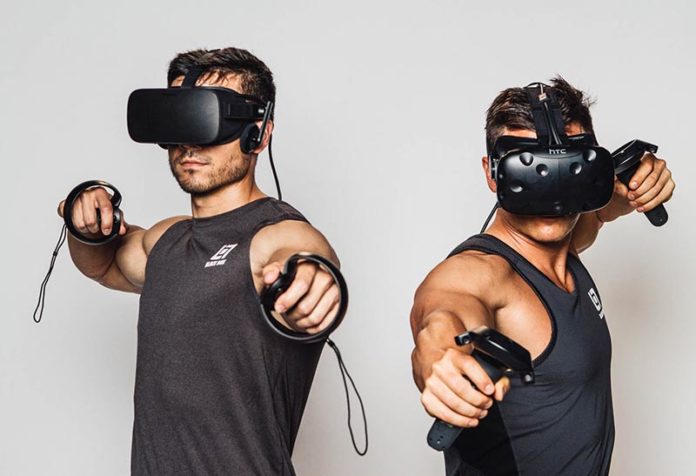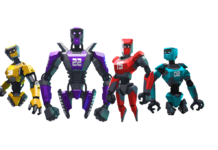It’s not news that VR games excel in serving out heightened fitness output and improved physiological health. Hundreds of millions of data samples gathered by the VR Health Institute over the past several years firmly establish this as fact. But does “VR fitness game” really compute for most consumers? Does it even compute for most VR consumers?
Playing VR games that help you burn calories is a great way to spend your gaming time, and while the fitness world is loving VR, in-home “VR for fitness” still has a long way to go before it reaches the level of cultural adoption that it’s most certainly capable of.
On a conceptual level, fitting “gaming” and “fitness” together under the same roof defies everything connotative with gaming. It even challenges what non-athletes believe about exercise and metabolism.
But it’s not that those are inherently bad things, though. They’re great. Challenging the sedentary nature of gaming and making the world healthier is why VR Fitness Insider exists in the first place.
On the other hand, even without the presence of VR Fitness Insider to nurture and inform, many people who’ve discovered this corner of the industry would have found their way here independently. Want proof? Rock Paper Shotgun’s Senior Editor, Alec Meer, practically tripped over the fitness benefits of VR gaming in his review of SUPERHOT VR.
Here’s my point:
Now that the first round of VR fitness games have woken people up to the fact that VR can truly help you transform your health, it’s the perfect time for an ambitious game developer to jump into the fray and take VR to the next level.
With a better grip on the gaming medium, VR developers can simultaneously improve the quality of their games and tap into the cultural phenomenon of VR fitness.
Below, I’ve explored some ideas about what a truly fantastic VR fitness game might look like. It won’t be overly like your traditional workout. Preferably, it won’t try to out-do traditional gym regimens at all—but rather supplement them and/or provide an alternative.
Granted, there’s totally a thread of this “perfect” VR fitness game DNA that exists right now in Beat Saber.
Beat Saber Represents a Foundational Building Block for Future VR Fitness Gaming
Beat Saber is one of the strongest VR fitness games in existence. Not only does it excel at helping people burn calories; it’s simply one of the best games you can currently play in VR.
It has sticky, fun, addictive gameplay. And the best part of it is that you never quite realize that it’s deliberately a VR fitness game. It’s totally a fitness routine, but you (the player) see it as a glorious lightsaber joust with pulsing rhythms.
That’s what VR fitness games need to be.
Daresay, Beat Saber boosted VR gaming through a threshold that the industry is unlikely to return from.
And why would it? The veil has been lifted. VR fitness games can be incredible, unique, one-of-a-kind experiences that make their players feel epic. We now know that VR fitness can satiate the gamer’s love of play as well as the athlete’s love of exercise.
But if you simulate The Gym, you’ll eventually leave many of your most qualified players wondering why they’re in a VR simulation instead of at a real gym. The luster will wear off, the illusion will wear off, and—for those players—VR will degrade into just another workout hack that pales in comparison to the real thing.
They’ll either graduate VR, or they’ll fall back into their old habits. But that’s not how any of this is supposed to work, is it?
Beat Saber, on the other hand, throws The Gym on its face and invites you to practice your lightsaber dual-wielding skills in a state of complete immersion.
Remember: VR isn’t about fitness. It’s about immersion.
VR’s fitness benefits come from users being so immersed in motion-activated gameplay that they forget they’re exercising entirely.
Here’s What Developers Can Do Better
You don’t have to copy Beat Saber—in fact, you probably shouldn’t. But you should take note of how its gameplay rewards you. Both by teleporting you somewhere you can’t go in real life, and also by rewarding you gratuitously for exercising.
That said, The Gym is a setting that’s been done to death in singleplayer. But it’s been done particularly well, too. I can’t imagine needing another singleplayer gym simulator beyond BOXVR and The Thrill of the Fight.
So if you’re going to make another gym, go above and beyond what already exists. Don’t make it about one gameplay loop; make it a platform for users to design and share their own gameplay loops. Make it multiplayer. Like Rec Room, but more structured.
Or, do what games like Sparc and Creed: Rise to Glory are doing. Give people a space to completely rag on each other.
VR excels as a way to hang out online and play games. It practically sells itself on that benefit with apps like BigScreen, Rec Room and VRChat. That’s an important facet of gaming that VR fitness developers owe themselves to tap into with future titles.
After all, friends help you get fit in VR.
“A Township Tale” Is a Creative Sandbox That Is, in Fact, a VR Fitness Game in Disguise
The thing about fitness gameplay is that you can implement it into just about any type of VR game.
For proof, look no further than A Township Tale. It seeks to be a multiplayer Harvest Moon-like sandbox where players work together and take on varying professions to build and maintain a town while also trying to survive, ala Rust. Familiar, right?
It’s a game that, on paper, does not sound like it helps you burn calories or build cardio. But that’s because games like A Township Tale are traditionally played on flat screen consoles and PCs.
And that’s why it isn’t actually familiar at all. It’s downright alien, and that’s a good thing.
By the fact that A Township Tale places you into the center of its world via VR, it knocks over every bit of context that players and designers of traditional survival sim games might have.
A prime example is how often you need to bend over to pick items up off of the ground. The answer: A lot. But that’s not where the real exercise comes from.
For example; fighting monsters in A Township Tale is very, very difficult.
Enemies take a lot of blows to die, and (in melee combat) your avatar’s swing force is proportionate to your own—meaning that if you wave your weapon around like a toy rubber chicken, you might tickle your opponent, but you definitely won’t hurt them. Just like in The Thrill of the Fight, it takes big, broad (and perfectly landed) swings to put a dent into any creepy crawlies that emerge in the dark.
But what about other gameplay systems? Well, you might find yourself hacking away at wood logs to carry a load of firewood back to the village. This works much the same way as combat, except you’ll find yourself kneeling over to take big swings with your axe, picking up each piece of loose wood and stowing it in your backpack.
How about foraging for fruits and vegetables on tall trees and bushes? That also strains you if you spend enough time doing it in repetition. If you’ve communicated to your buddies that you’re the town’s source of food, then you’ll be out and about in the forests collecting food quite often, which of course will land you face-to-face with monsters.
Which means more combat. You get the picture.
Of course, you’ll put the same level of effort into mining, chiseling, cooking, crafting, and setting up campfires.
It’s a game that successfully drops you into the head of a hunter/gatherer/farmer as you fend for yourself and your fellow villagers. It satisfies the gamer’s love of play, but it also makes them sweat. Best of both worlds. Mission accomplished.
Conclusion
Future generations of VR fitness games need to aim at being better games, first.
Beat Saber is the first true-blue VR fitness game that you could spend hours of your life in for the simple pleasure of gaming, while also burning tons of calories and getting into high-intensity routines.
But while Beat Saber definitely fits the bill for a killer app, I subscribe to the belief that future VR fitness games can’t only get by with the promise of “leveling you up” in real life. They need to level your avatar up in the game as well, so to speak. There needs to be a context for gameplay.
The Thrill of the Fight does a good job of making you hate some of its opponents, that’s for sure. But once they’re beaten, they’re beaten. The illusion is gone at that point. You can keep challenging yourself to beat them at higher levels of difficulty, but there’s no larger “game” to beat. Also, there are no other real humans around to compete against either.
In contrast, Beat Saber compels you to keep playing because of how epic its gameplay makes you feel. People want to watch others play it and compete over high scores. It has a rich modding community that creates lasting value. The unique emotions that Beat Saber is capable of coaxing are what makes it so special (and useful as a long-term fitness regimen).
And, when it’s time, Beat Saber will be vastly improved by multiplayer.
Do you agree with me that VR fitness games still have a ways to go before they hit the mainstream? Let me know in the comments.











